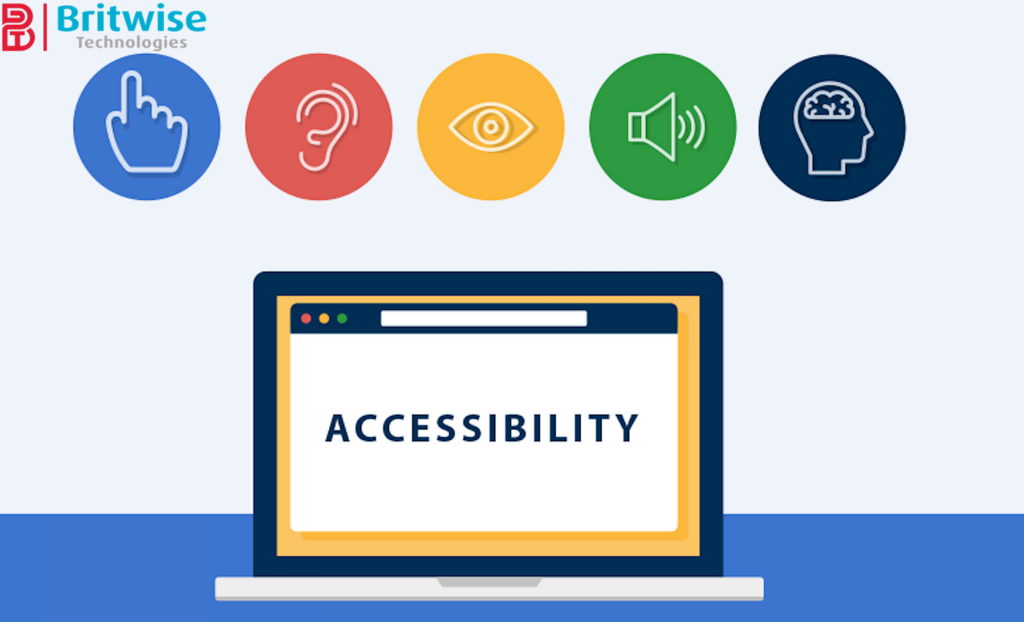Web Accessibility in React JS

Web availability guarantees that all clients, counting those with inabilities, can get to, explore, and associated with websites viably. This is particularly pivotal for ReactJS applications, known for their energetic and intelligently nature.
By prioritizing openness, web architects and designers make comprehensive advanced encounters that cater to assorted client needs, taking after the Web Substance Availability Rules (WCAG) distributed by the Web Openness Activity (WAI) of the World Wide Web Consortium (W3C).
In this web journal post, we’ll give commonsense tips to improve the openness of your web pages, examine the utilize of ARIA parts and point of interest components, and guarantee adequate color differentiate.
By the conclusion of this post, you’ll get it how to execute these web availability rules in your Respond app, test for openness issues, and make web applications that meet the needs of all clients, guaranteeing compliance with the most recent openness standards.
Importance of Web Accessibility
Accessibility Standards: POUR
Web availability is significant for guaranteeing that all clients, counting those with incapacities, can get to and associated with web substance. The center standards of availability, as sketched out by the Web Substance Availability Rules (WCAG), can be summarized utilizing the acronym POUR: Discernible, Operable, Justifiable, and Robust.
A. Perceivable
Data and client interface components must be satisfactory to clients in ways they can see. This implies giving content options for non-text substance, making substance that can be displayed in diverse ways (e.g., easier format) without losing data or structure, and guaranteeing that cotnent is recognizable. For illustration, guaranteeing adequate color differentiate and giving captions for multimedia.
B. Operable
Client interface components and route must be operable. This incorporates making all usefulness accessible from a console (console route), giving clients sufficient time to studied and utilize substance, not planning substance in a way that is known to cause seizures, and giving ways to offer assistance clients explore, discover substance, and decide where they are.
C. Understandable
Data and the operation of the client interface must be justifiable. This includes making content clear and reasonable, guaranteeing that web pages work in unsurprising ways, and making a difference clients maintain a strategic distance from and adjust mistakes.
For case, utilizing clear and basic dialect, giving content choices for bizarre words, and guaranteeing that web applications give input when clients make errors.
D. Robust
Substance must be vigorous sufficient to be deciphered dependably by a wide assortment of client specialists, counting assistive advances. This implies guaranteeing compatibility with current and future client tools.
For case, guaranteeing that web pages are in reverse congruous with more seasoned innovations and that unused advances and ARIA parts are appropriately used.
Legal and Moral Reasons for Accessibility
A. Legal Requirements
In numerous locales, counting the Joined together States and the European Union, there are legitimate prerequisites commanding web openness.
In the U.S., the Americans with Inabilities Act (ADA) requires that websites be available to individuals with disabilities.
The Web Openness Activity (WAI) of the World Wide Web Consortium (W3C) has distributed the WCAG 2.0 and 2.1, which give a set of rules and victory criteria for making web substance more available.
Websites that do not comply with these rules chance legitimate activity and penalties.
For case, accomplishing WCAG 2.0 Level AA victory criteria is frequently a legitimate prerequisite for government and open segment websites.
B. Ethical Considerations
Beyond lawful prerequisites, there are solid moral reasons to improve openness.
Open plan guarantees that all individuals, in any case of their capacities, can get to data and administrations on the web.
This incorporates individuals with inabilities such as moo vision, hearing disabilities, and engine disabilities.
Providing an comprehensive online involvement is not as it were the right thing to do but too extends the potential client base for web originators and site proprietors.
By tending to availability obstructions, we guarantee that web substance is usable by a more extensive group of onlookers, counting those depending on assistive innovations like screen perusers and other shapes of client agents.
Dynamic UIs in ReactJS and Accessibility
ReactJS, known for making energetic single-page applications (SPAs), presents one of a kind challenges in web openness. These challenges emerge due to the exceedingly intuitively nature of SPAs, where substance upgrades powerfully without full-page reloads.
Ensuring web openness utilizing ReactJS requires cautious consideration to the Web Substance Availability Rules (WCAG) and leveraging best hones to make energetic substance accessible.
A. Keyboard Route and Center Management
React apps frequently include complex intelligent, requiring vigorous console route. Overseeing console center gets to be challenging as energetic components can disturb the characteristic tab arrange. Engineers must guarantee that console center is overseen accurately to improve openness, giving clear and coherent route paths.
B. Screen Peruser Compatibility
Dynamic overhauls in Respond applications can make openness boundaries for screen peruser clients. Guaranteeing screen perusers declare changes suitably requires actualizing ARIA (Open Wealthy Web Applications) parts and properties. Engineers must test with different screen peruser computer program to confirm that overhauls are reported precisely, giving fundamental setting for users.
C. Accessible Plan and Client Experience
Dynamic UIs frequently depend on modular windows and other intuitively components. These components must be outlined with openness in intellect, guaranteeing they are safe by means of console and legitimately labeled for screen perusers. Utilizing point of interest components and ARIA parts makes a difference clients with incapacities explore and get it the structure of the web page.
State Administration Issues in ReactJS and Accessibility
State administration in ReactJS includes dealing with the different states of a web application, which can altogether affect openness. Compelling state administration guarantees that changes in the application’s state are communicated clearly to all clients, counting those utilizing assistive technologies.
A. Dynamic Substance Updates
React’s state-driven approach implies that substance can alter without a page reload. Guaranteeing these upgrades are available requires adherence to availability rules, such as giving content choices for energetic substance and guaranteeing adequate color differentiate for lucidness. Screen perusers must be educated of these changes to give clients with the fundamental context.
B. Assistive Innovation Support
Ensuring that state changes are available to assistive advances includes utilizing fitting ARIA properties and parts. For case, overhauling the record title or giving captions for interactive media substance makes a difference screen perusers pass on the upgraded data to clients effectively.
C. Testing Accessibility
Regularly testing the openness of Respond applications is pivotal. Utilizing apparatuses that assess WCAG 2.0 and 2.1 Level AA victory criteria makes a difference recognize and address availability issues. Testing ought to incorporate scenarios for different assistive advances, console route, and mouse input to guarantee comprehensive availability support.
D. Handling Shapes and Inputs
Managing the state of shape components and other input sorts in Respond requires cautious thought to dodge availability obstructions. Guaranteeing that frame components are appropriately labeled and giving input in an available way upgrades convenience for all clients. Actualizing appropriate console center administration and ARIA live locales makes a difference communicate changes in shape states to screen perusers.
Best things to do for Availability in ReactJS

Creating open web applications is fundamental to guarantee inclusivity and ease of use for all clients, counting those with incapacities. When creating with ReactJS, taking after these best hones can offer assistance you meet the Web Substance Openness Rules (WCAG) and improve the openness of your web pages.
A. Semantic HTML
Using semantic HTML components such as , , and is principal to web availability. These components give significant setting to assistive advances like screen perusers, permitting clients to explore and get it web substance more efficiently.
Using ARIA parts and properties appropriately guarantees that assistive innovations can translate and associated with your web application correctly.
B. Keyboard Navigation
Ensuring that all intelligently components are available through console alone is vital. Numerous clients depend on console route, counting those with engine inabilities and screen peruser clients. Actualize appropriate tabindex administration and occasion handlers to encourage this
C. Focus Management
Managing center states is basic for consistent route. When clients associated with modular windows, shapes, or other energetic substance, suitably setting and keeping up center makes a difference them explore without confusion.
D. Accessible Forms
Creating open shapes includes giving clear names, blunder taking care of, and approval messages. Names ought to be expressly related with their comparing input areas utilizing the for trait or aria-labelledby.
Additional Considerations
- Sufficient Color Differentiate: Guarantee content and foundation color differentiate meets WCAG 2.1 Level AA victory criteria.
- Text Options: Give content options for non-text substance, such as pictures and icons.
- Landmark Components: Utilize point of interest components (, , ) to characterize locales of the page
- Testing Openness: Routinely test your Respond app with devices and assistive innovations to distinguish and address availability issues.
Testing Tools
Ensuring web availability in ReactJS applications is fundamental for making comprehensive computerized encounters. To accomplish this, engineers can utilize a combination of robotized instruments and manual testing techniques.
Automated devices like Hatchet DevTools and Beacon are profitable for checking web pages and Respond components for availability issues. These devices offer assistance recognize infringement of WCAG 2.1 Level AA victory criteria, guaranteeing that web substance meets the vital benchmarks for accessibility.
Manual testing with screen perusers such as NVDA or VoiceOver is pivotal to confirm that all intelligently components are safe and justifiable for clients depending on assistive technologies.
Additionally, testing console route guarantees that clients can connected with the application without the require for a mouse, improving openness over diverse client needs. For clients who depend on screen perusers, optimizing Respond applications includes a few considerations.
Using semantic HTML components like , , and gives structure that makes a difference screen perusers explore substance viably. Actualizing ARIA parts and properties advance upgrades availability, guaranteeing that intuitively components like modular windows are accurately distinguished and navigable.
Providing content options for non-text substance and overseeing console center are too basic to making a consistent involvement. By following to these hones and considering the differing needs of clients, engineers can make strides the ease of use and inclusivity of their Respond applications, making them available to a broader group of onlookers whereas adjusting with worldwide availability measures and guidelines.
Final Thoughts
In conclusion, prioritizing web openness in ReactJS applications is fundamental for making comprehensive computerized encounters. By following to the Web Substance Availability Rules (WCAG), designers guarantee that their applications are distinguishable, operable, reasonable, and strong for all clients, counting those depending on assistive innovations like screen readers.
Throughout this web journal post, we’ve investigated the interesting challenges postured by ReactJS, such as overseeing energetic interfacing and state changes, and we’ve laid out best hones to overcome these deterrents. Emphasizing semantic HTML, leveraging ARIA parts and qualities, optimizing console route, and overseeing center states are foundational steps toward accessibility.
Testing and guaranteeing WCAG conformance with apparatuses that reenact client encounters with inabilities is basic to conveying on the guarantee of an comprehensive web. By grasping these standards and hones, designers not as it were meet legitimate and moral commitments but moreover improve convenience and client encounter for a different group of onlookers.

